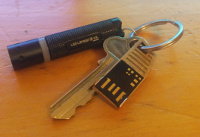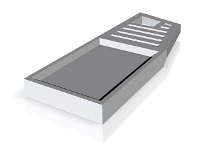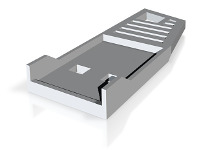3D printed minimalist USB keyring
January 2014

About
I like the idea of carrying some useful data around with me wherever I go, and with USB keys getting smaller and smaller it's quite possible to get ones that will fit on your keychain.
With this in mind, I bought a SanDisk Cruzer Force with a metal casing in late 2013. The metal body of the USB key was good because it meant that I didn't need to worry about it in my pocket along with keys and whatever other crap I had in there at the time.
Sadly, in early January the actual USB PCB came loose in my pocket and came away from the casing, it still worked but without the case it needed to be supported by some card or a piece of plastic to read in a PC.
So I decided to 3D print a new case!
Process
Using Google Sketchup, I designed a small USB 'shim' which was desinged to precisely fit the USB PCB that had come loose, and replace the old, slightly bulky casing.
My design needed to be:
- Functional: It needed to fit into a USB socket, and make provide the USB PCB with physical connection to the contacts on the recepticle.
- Rugged: It was going to live in my pocket with my keys (metal)
- As small as possible: I don't like having a bulky keyring
Having recently discovered that Shapeways had begun printing in metal, I took the opportunity to give the process a go.
Revision 1

The first design, pictures to the right was functional, just.
It fit the USB PCB after a small amount of filing, and when I plugged it into a PC's USB socket, it would register as a flash drive. Unfortunately, because of the metal 'lip' at the front of the device, it would momentarily short out the 5V and GND pins on a USB connector.
While some PCs can handle this momentary short circuit and will just give you a warning, others are not so forgiving and will immediately power off as a safety precaution.
In addition to this fault, the device can be inserted upside down, which would also short circuit the USB device, albeit more permanentlty. It's not likely that this would cause any real harm in most devices, but it's hardly ideal.
Revision 2

To address the problems of the first design, a few changes were made.
- The indentations on the underside of the keyring were pushed through to make small holes.
This allows the USB PCB to be removed if it comes faulty or a larger chip becomes available. - Small 'horns' were added to the front of the design.
This prevents accidental reverse insertion, while minimizing the volume added to the print to keep costs low. - The front lip of the device was lowered.
This still keeps the chip in place, but avoids instantaneous short circuits between the power rails of the USB connector while inserting the device. - The width of the 'tray' was expanded ever so slightly to allow the USB chip to fit in without needing to sand/file it down.
As a result, the chip may need a dab of some kind of adhesive to keep it from falling out, but I'd rather that than have to sand down the PCB. Variations in printing may also be at work here.